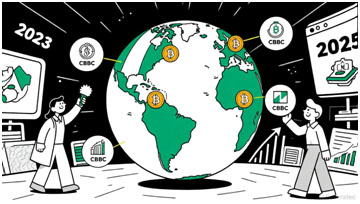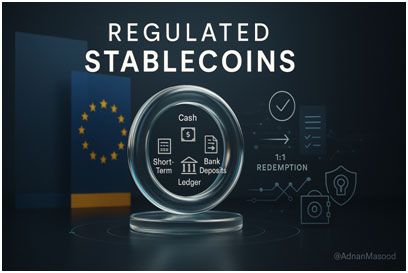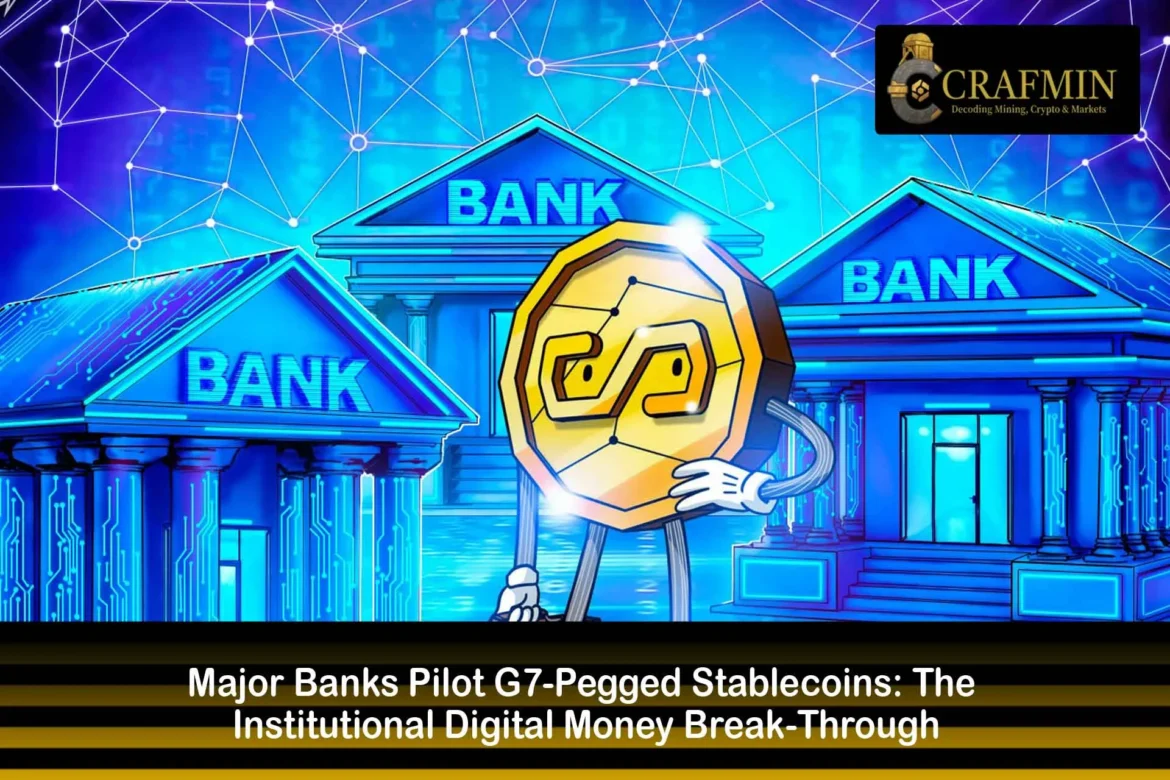Lead: The Most Important Facts, First
Ten of the largest banks in the world; Bank of America, Deutsche Bank, Goldman Sachs, UBS, Citi, MUFG, Barclays, TD, Santander and BNP Paribas release a joint initiative to pilot the issue of reserve-backed stablecoins 1:1 pegged to G7 currencies and issued on public blockchains. The pilot will assess compliance, risk management, liquidity and technical architecture required to facilitate trusted digital money at scale. (Reuters)
It is not a one-off action by one bank, but rather coordinated trials by heavyweights who have previously been on each side of the market debate. The move is an overture by old finance to get into, and maybe have some impact on, the new cross-border payments and digital settlement rails. (Reuters)

Banks Launch G7-Pegged Stablecoin Pilot: A Major Shift in Institutional Digital Money (Image Source: Yahoo Finance)
Why This Matters Now
Stablecoins already drive much crypto activity, ranging from decentralized finance trading. Still, however, it is a market dominated by a few private issuers, some non-bank institutions. A G7-backed product underwritten by international banks can tip confidence and usage trends, and drive stablecoins further into mainstream payments, treasury management and cross-border flows.
While regulators and central banks watch, legislators in major jurisdictions have moved forward to pass stricter regulations on stablecoins this year to date, while central banks are searching for CBDC simultaneously. The bank cycle comes to a fork: transparency regarding regulation rises, but system problems remain on the agenda. (Reuters)
Snapshot: What They Say And What They Do
The banks describe the initiative as exploratory, a pilot, and a structure, not issuance. They detail the goal succinctly: experimenting with a 1:1 reserve-backed digital currency that can be run on public blockchains but has rigorous compliance and audit needs fulfilled. Expect proof-of-concepts, governance structures, and legal research before any public launch. (Reuters)
That amounts to words. “Reserve-backed” is intended to convey full fiat backing and transparency, precisely what regulators require. Public blockchains maximize extensiveness and integrability at the expense of new security and privacy issues.

Banks Call It a Compliance Pilot, Not a Full Stablecoin Launch (Image Source: Chaintech Network)
A Brief History Lesson: Concise And To The Point
Stablecoins were created to solve an off-chain problem: send value across blockchains and exchanges without exposing the users to crypto volatility. Tether and USDC are the two behemoths, but both of them have their vulnerabilities in reserve, governance and regulatory exposure risks.
The banks have already piloted tokenisation. Societe Generale, for instance, already had a dollar-denominated, use-limited token out in a previous test. Euro tokens went through a pilot test conducted by European banks last spring. The new G7 club is taking that incremental step, but scaling it with the brand weight of institutions like large bank brands. (Reuters)
The Technical Picture: How Would It Be Done?
Do it as a bank-grade-controlled token issuance company.
Peg mechanics: Fiat 1:1 redemptions for each token are stored in reserved high-quality segregated reserves. Banks must implement an audit rhythm, open proof of reserves, and redemption rules.
Blockchain layer: They will use public blockchains to reach most. That choice adds composability (apps can be written on tokens) but requires quality AML/KYC middleware and potentially privacy layers.
Interoperability: When different banks are issuing on different chains, bridging and settlement regulation will matter. Interoperability protocols and atomic settlement architecture will have a central role in pilots.
Smart contract risk: Factory contracts require formal verification, multisig custody, and upgrade governance. Banks require fail-safes, pause features, and permissioned recovery when they’re dealing with decentralized access.
This mix of public tracks and institutional disciplines can generate a hybrid structure: broad-scale tokens administered and regulated by stringent banking disciplines.
Regulatory Hotspots
Three big questions are posed by regulators.
First: systemic risk. As bank-backed stablecoins have systemic implications on local deposits and liquidity in emerging markets and generate new shock transmission, disintermediation and capital flight from vulnerable banking systems are of concern to institutions and central banks. Modeling now suggests that stablecoins can suck massive amounts of money out of emerging market deposits under certain circumstances. (Reuters)

Regulators Flag Systemic Risk: Stablecoins Could Drain Deposits from Emerging Markets (Image Source: AInvest)
Second: monetary sovereignty. Widespread use of foreign-pegged stablecoins can undermine home-country control over money. Regulators in the Eurozone and elsewhere wrestle with how best to encourage domestic digital innovation, like the digital euro, while promoting innovation. (Reuters)
Third: consumer protection and transparency. Regulators insist on clean reserve backing, audited balance sheets and high-quality operating resilience. The GENIUS Act and the like elsewhere make dollar-pegged tokens more tightly regulated and will force any U.S. participation. (Reuters)
Incentives To Business: Why Banks Join
Several drivers encourage banks to join.
Preserve market share: if payment revenues are disintermediated by fintechs and crypto players, banks must join or be left without rails.
Speed and expense: Settlement of payments on a blockchain will lower clearing times and lower correspondent banking charges on cross-border transactions.
New product rails: Tokenized liquidity can enable instant corporate treasuries, programmable payments and improved FX execution.
Regulatory head start: Compliance is integrated into the product on day one; an early benefit over unregulated issuers.
Short and sweet, there’s a competitive threat and opportunity for banks.
Real-World Use Cases That Matter
Imagine a G7 token-payed multilateral payroll: speed, surety and reduced FX friction. Imagine trade invoices being paid by companies through paying in tokenized fiat to reduce payment float. Imagine treasury teams sweeping over residual funds into tokenized balances, settling in minutes across borders.
In emerging markets, stablecoins are a lifeline to avoid local currency volatility where available and accessible. In capital markets, tokenized near-term securities (tokenized deposits, treasury bills) will be more liquid when there are stable settlement rails.
Stablecoins are moving from trading desks to real-world payment rails
As @chrisharmse89 explains, the fastest-growing use cases aren’t speculative, they’re operational:
• Creator & marketplace payouts – platforms like @deel pay contractors instantly across borders.
• B2B… pic.twitter.com/cM8smtGrZd
— 51 | fiftyone.xyz (@fiftyonexyz) October 10, 2025
The Coming Risks
There is no experimentation risk-free except for business as usual.
Liquidity squeeze: A token redemption marathon can strain sponsor banks in the event that their reserves are illiquid or ill-managed.
Operational concentration: With few banks responsible for issuance and valuation, the tokens will concentrate power and foster regulatory pushback.
Privacy and censorship: Public blockchains’ traceability can cause banks and regulators to require lower-level privacy-denying transaction controls or flow censorship.
Tech failure: Smart contract menace or cross-chain bridge attack remains at the top of the list.
Design must consciously design worst-case scenarios; resolution playbooks, stress tests, and cross-jurisdiction coordination.
How Is It Different From CBDCs And Tokenised Finance
Central bank digital currencies (CBDCs) and bank-issued tokens overlap but differ in mandate.
CBDCs: Monetary policy tools; central banks retain control over creation and monetary characteristics.
Bank stablecoins: consortium or private vehicles to enhance payment, liquidity and market efficiency.
They can coexist. Consumer payments can be made on the basis of CBDCs in certain countries with tokenised private instruments for wholesale and corporate use. Others can use industry solutions supplemented by CBDCs. It will be technical and political. (Reuters)
Global Implications: Winners And Losers
If banks are successful, advanced economies and large corporates will be most quickly benefited: quicker settlement, better cross-border cash management, and on-chain liquidity.
They have some problems to deal with, however. Domestic consumers hold low-friction stores of value, domestic banks suffer flight of deposits, and regulators worry about monetary sovereignty and evasion of capital controls. Standard Chartered estimates dollar-pegged stablecoins can sweep vast sums out of EM banking systems in minutes if adoption speeds up. (Reuters)
The Political Dimension: Who Is In Charge?
Politics matter. Europe, America and G7 lawmakers now discuss regulating stablecoins. The U.S. does have one piece of legislation this year that established a framework for dollar-backed tokens, but international coordination is patchy. The bank group would be delighted to help regulators, but governments can have stringent regulations or prohibit foreign use in unstable geographies. (Reuters)
Possible Developments Over The Next 12–36 Months
Pilot to product: Pilots are conducted by banks, reserve and compliance structures are addressed, and local products are rolled out to institutional and corporate users. Take-up is established in stages with restricted retail access permitted by regulators.
Complementary model: CBDCs and bank tokens are in distinct niches; CBDCs for retail, bank tokens for wholesale and corporate business. Interoperability frameworks arise.
Regulatory strangulation: Governments enforce tight controls on retail cross-border payment stablecoin use by the private sector, suppressing take-up and driving stablecoins down institutional channels.
Backlash and concentration: Failure of security or transparency unleashes suffocating inhibition. Bank-sponsored, tightly regulated tokens only remain.
All roads depend on technical architecture, political will and market drivers of take-up.

Stablecoin Outlook: Rollout or Restriction Depends on Tech, Policy and Adoption (Image Source: Electronic Payments International)
Market Voices (Synthesis)
Industry watchers look at this as a turning point. Crypto maximalists see bank tokens as a centralizing culture of decentralization threats. Institutional fund managers see them as a regulated entry into traditional finance and blockchain efficiency. Regulators see these tokens as a means of channeling innovation into regulated systems instead of suppressing it.
The end product, if there is one, must provide three: trust, liquidity, and compliance. If it does, it can convert the value to be transmitted across the world.
Treasury And Corporate Guide To Working With
Are you a treasurer or corporate cash manager? Start pushing your bank counterparts:
- Will pilots take corporates as legitimate users?
- How will settlement and redemption work across time zones?
- What reports of reserve and audit will they provide?
- What blockchains fall under the scope and how are custody arrangements managed?
- How are cross-chain FX and transfers managed?
Being an early mover positions you to design workflows optimized for speed value without compromising counterparty risk.

Treasury Checklist: What Corporations Must Clarify Before Using Bank Stablecoins
Technical Checklist That All Pilots Must Share
- Open proof-of-reserves methodology and third-party independent audits.
- Legal settlement process in place for fiat redemptions.
- On-chain and off-chain compliance integration (KYC/AML).
- Effective contract upgrades and emergency stoppage management.
- Stress test resolution playbooks and their consequences.
Transparency on this will establish market confidence faster than advertising.
Ground Stories: The Human Element
Consider the example of a Lagos micro-exporter who currently spends five working days and enormous correspondent charges to get foreign invoices. She pays in minutes using a bank-backed G7 token whose acceptability is guaranteed by her buyer, and FX spreads are reduced. That time saved is work capital, growth horsepower, and margin replenished.
Now imagine the family having some secure digital funds to keep domestic currency turbulence at bay. Token access is realistic, not political, to them. They are the people’s implications at stake when monolith finance redraws the tracks.
Counterarguments And Critics
It is referred to as encroaching surveillance, over-centralization of power, and money-sucked-out local banking by its critics. They say that private bank tokens can suck retail deposits out of banks and leave developing economies open to foreign currency exposure. The case will be design-based: are bank tokens permissioned for commercial corridors, or would they be universal?
The critics illuminate that the banks are able to utilize good transparency, good control, and governance by regulation to construct, but their advocates respond that if they do, society gains in the form of faster payments and safer settlement than under the existing regime of fragmentation.
What To Watch For Next: Timely Indicators
- Official pilot reports or white papers of the group. (Due in later quarters.) (Reuters)
- S., EU, and G7 central bank guidance on retail versus wholesale use. (Reuters)
- Proof-of-reserves technology and third-party bank audits.
- Traditional stablecoin challengers’ market response to liquidity rebalancings, trading volumes, or alliances. (com)
Frequently Asked Questions (FAQs)
Q1: What is a G7-pegged stablecoin, anyway?
A G7-pegged stablecoin is one-for-one parity electronic money with parity to Group-of-Seven fiat currencies (USD, EUR, GBP, CAD, JPY, etc.) backed by reserve investments made by reputable institutions. (Reuters)
Q2: Will bank tokens replace bank deposits or currency?
Not first. They are electronic settlement devices. General adoption by retailers can affect long-term deposits, but regulators and banks will certainly have access controls and protection of redemption to prevent disintermediation risk. (Reuters)
Q3: What are regulators going to do?
Regulators will demand transparency, withholding of audits, and worst-case planning. Variation by jurisdiction will be significant: some nations are open to permissive regimes; others limit private stablecoins to encourage CBDCs. (Reuters)
Q4: Are public blockchains secure enough for bank money?
Public blockchains have widespread availability and persistence, but at the expense of exposure to smart contract risk and privacy. Banks will certainly include features for extra custody, governance, and monitoring to mitigate those risks.
Q5: When can the tokens be rolled out?
Pilot tests take several months; roll-outs of manufacturing take 12–36 months, depending on results and regulatory clearance. The consortium refers to the project as an early stage. (Reuters)
Conclusion: Why It Matters
This world of the bank is an era where traditionalist is not faced with crypto or wholly in decentralisation. Banks are, though, eager to mix institutional trust and blockchain efficiency. Whether it becomes the new institutional digital money standard or not will be decided by design discipline, regulatory clarity and real-world take-up.
For journalists, product managers, and treasury professionals, this is a story about more than a technical novelty. It follows how money itself can be re-engineered: quicker, programmable, and most significantly, under the custody of institutions that have spent centuries building the financial system as it is today.

